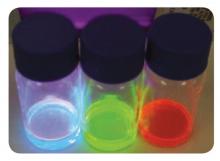Universal Display reports advances in its UniversalP2OLED solution-processable material's performance: lifetime, efficiency and operation voltage. Solution-processable OLEDs can be used in ink-jet printing and other manufacturing techniques that can result in cost-effective production of large-size OLED panels. UDC says that commercial viability is now "in sight".

- The green P2OLED system, which offers a luminous efficiency of 68 candelas per Ampere (cd/A), has now achieved 175,000 hours of operating lifetime. This is a 34% increase over the last reported value (130,000 hours).
- The red P2OLED system, with a luminous efficiency of 18 cd/A, now offers an operating lifetime of 125,000 hours (a 100% increase over the last reported value of 62,000)
- The light blue P2OLED system now offers a luminous efficiency of 29 cd/A and 8,000 hours of operating lifetime (a 60% increase in efficiency and lifetime).
This is a large performance increase when you consider that the last values were reported in October 2010 - which was only 6 months ago.
Plextronics released their own PR today, saying that UDC's system uses their Plexcore OC NQ ink. UDC has been using the same ink in their previous system reported in October 2010. The OC NQ is only available for limited sampling to key customers and partners. This ink is a non-aqueous-based Hole Injection Layer (HIL) ink which is geared specifically for solution processable phosphorescent OLED emitters.

